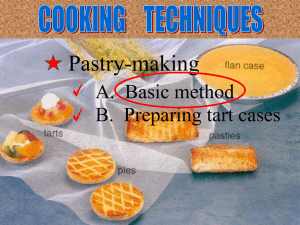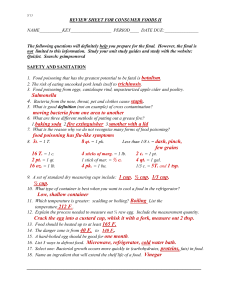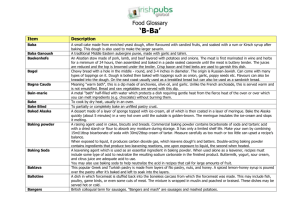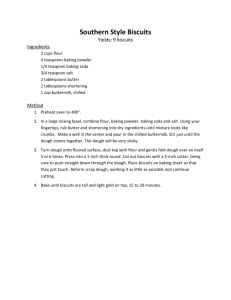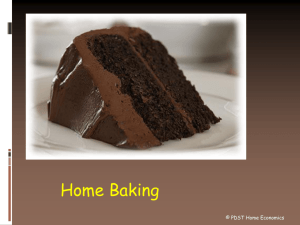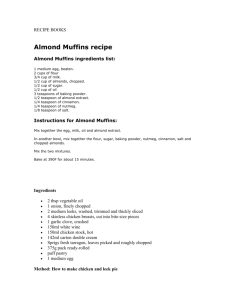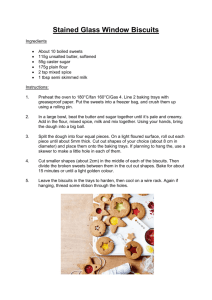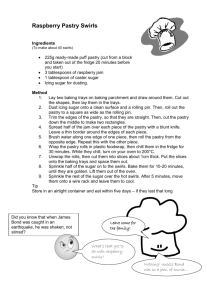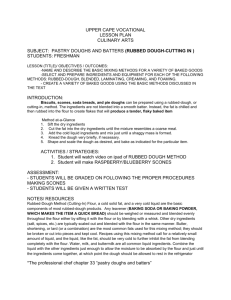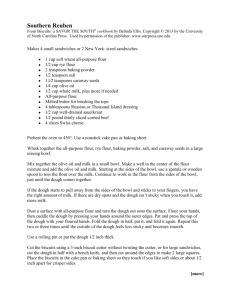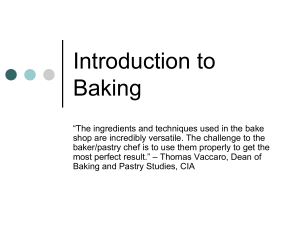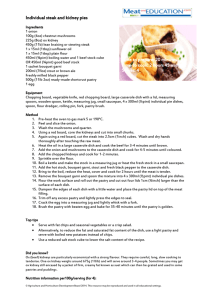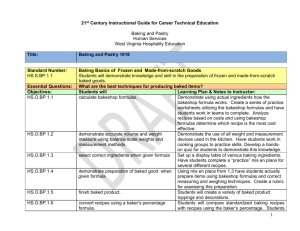temperatures
advertisement
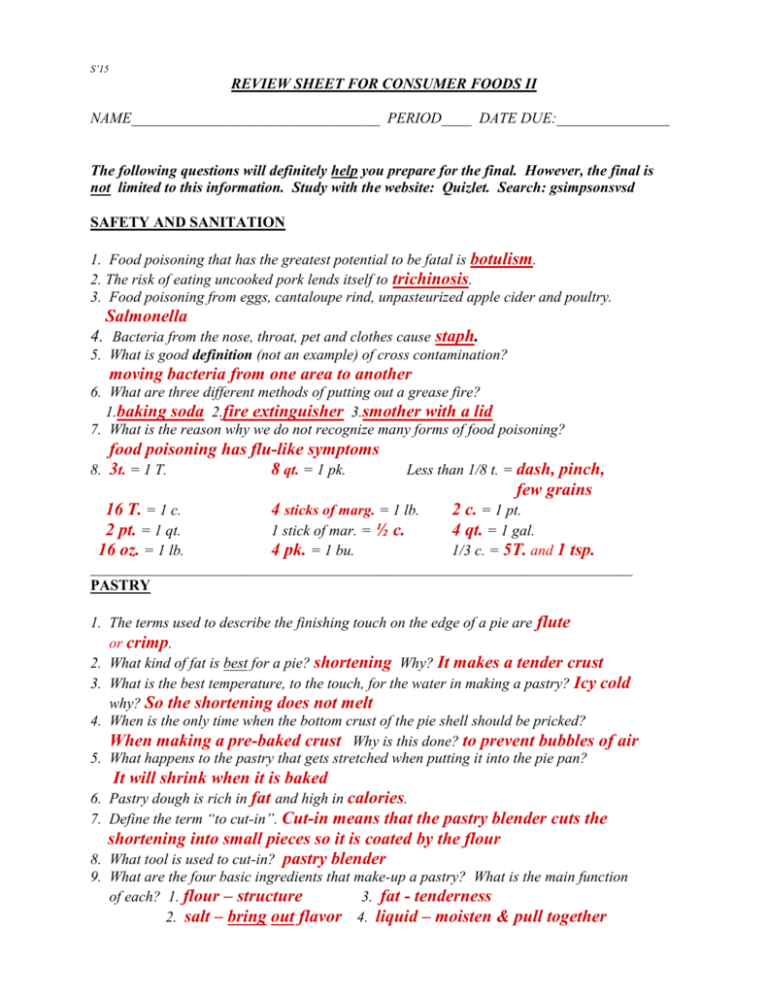
S’15 REVIEW SHEET FOR CONSUMER FOODS II NAME_________________________________ PERIOD____ DATE DUE:_______________ The following questions will definitely help you prepare for the final. However, the final is not limited to this information. Study with the website: Quizlet. Search: gsimpsonsvsd SAFETY AND SANITATION 1. Food poisoning that has the greatest potential to be fatal is botulism. 2. The risk of eating uncooked pork lends itself to trichinosis. 3. Food poisoning from eggs, cantaloupe rind, unpasteurized apple cider and poultry. Salmonella 4. Bacteria from the nose, throat, pet and clothes cause staph. 5. What is good definition (not an example) of cross contamination? moving bacteria from one area to another 6. What are three different methods of putting out a grease fire? 1.baking soda 2.fire extinguisher 3.smother with a lid 7. What is the reason why we do not recognize many forms of food poisoning? food poisoning has flu-like symptoms 8. 3t. = 1 T. 8 qt. = 1 pk. Less than 1/8 t. = dash, pinch, few grains 16 T. = 1 c. 2 pt. = 1 qt. 16 oz. = 1 lb. 4 sticks of marg. = 1 lb. 1 stick of mar. = ½ c. 4 pk. = 1 bu. 2 c. = 1 pt. 4 qt. = 1 gal. 1/3 c. = 5T. and 1 tsp. ________________________________________________________________________ PASTRY 1. The terms used to describe the finishing touch on the edge of a pie are flute or crimp. 2. What kind of fat is best for a pie? shortening Why? It makes a tender crust 3. What is the best temperature, to the touch, for the water in making a pastry? Icy cold why? So the shortening does not melt 4. When is the only time when the bottom crust of the pie shell should be pricked? When making a pre-baked crust Why is this done? to prevent bubbles of air 5. What happens to the pastry that gets stretched when putting it into the pie pan? It will shrink when it is baked 6. Pastry dough is rich in fat and high in calories. 7. Define the term “to cut-in”. Cut-in means that the pastry blender cuts the shortening into small pieces so it is coated by the flour 8. What tool is used to cut-in? pastry blender 9. What are the four basic ingredients that make-up a pastry? What is the main function of each? 1. flour – structure 3. fat - tenderness 2. salt – bring out flavor 4. liquid – moisten & pull together 10. What are the two ingredients that make up a meringue? egg whites and sugar What allows the making of a meringue to be successful? keep yolk out of it (fat) which causes the meringue not to form 11. What actually makes the layers in a pastry - - how does it happen? the shortening melts and is replaced by the steam 12. What are three reasons why a pastry would become tough? 1.over-handling 2. re-rolling 3. warm water 13. How do you determine when you have rolled out a pastry dough far enough? 1. 1 – 2 in. larger than inverted pie pan 2. 1/8 inch thick 14. What kinds of pies need to be refrigerated? 1. ones with eggs and 2. milk 15. What kind of pie is made with a thickened pudding mixture? custard 16. What is the pastry method called that we use in class? conventional 17. How do cream puffs differ from pies crusts? develop gluten for cream puffs (long gluten strands) 18. When is it possible to refrigerate and/or freeze cream puff batter? before baking as a raw dough 19. Why is cream puff dough so bland? It is the filling that makes the flavor 20. When should cream puffs be filled? no more than 2 hrs. before serving 21. Which pastry would you use if the recipe called for a “plain” pastry? pie ________________________________________________________________________ FONDUE 1. Who invented the fondue? Swiss Why? To use up old cheese & stale bread 2. The most versatile fondue pot material is made from metal Why? Ceramic pot would crack at high temperatures 3. Why is the fondue pot designed larger at the bottom and smaller at the top? stability 4. Why are fondue forks color-coded? To know which fork is yours 5. What ingredient is used to decrease the amount of splattering of a hot oil fondue? 1 tsp. of salt 6. What are three reasons why you do not eat off of a fondue fork? 1. sharp 2. hot – conducts heat 3. unsanitary – (double dipping) ________________________________________________________________________ COOKIES 1. What are the six different types of cookies or cookie categories? Can you give an example of each? 1. bar - brownies 3. pressed - spritz 5. molded – peanut 2. drop – choc. chip 4. rolled – cuts-outs blossoms 6. refrigerator – pinwheels 2. Why is melted butter not acceptable in recipes that call for softened butter? Changes the consistency of the dough 3. Explain how soft and crisp cookies should be stored? Crisp – loose lid container Soft – air-tight container 4. What keeps cookie dough from spreading too much during the baking process? Chill the dough ( to soften hard brown sugar or soft cookies, add a lettuce leaf, slice of apple or a piece of bread and remove after a day or so) ________________________________________________________________________ QUICK BREADS 1. How does a quick bread differ from the bread for a sandwich? Quick bread is made from baking powder & sandwich bread is made from yeast 2. What are two characteristics of muffins that have been over-mixed? 1. tunnels 2. toughness 3. What are the three different categories of quick breads and what are the ratios of flour to liquid? 1. pour, 1 to 1 2. drop, 2 to 1 3. soft dough, 3 to 1 4. Why do some quick breads use buttermilk instead of regular (sweet) milk? It needs the acid 5. How do you substitute regular milk for buttermilk? Milk + vinegar or lemon juice 6. What is the most common leavening agent used for making a quick bread? Baking powder 7. What kind of a baking dish/pan would you use if you want the product to be lightly browned? Shiny aluminum Why? It reflects the heat darker in color? Dark inside finish Why? Dark absorbs the heat ________________________________________________________________________ SOUPS AND STEWS 1. What are the two main ingredients of soups? liquid and thickener 2. Define what bisque is. A rich cream soup from fish, shellfish and/or veggies 3. A soup, regardless of its starting form (frozen or canned) that needs to be made with water is called condensed soup. 4. How do you get a dark stock? dark stock is made by browning beef, adding water or red wine, heating up the mixture and scraping the bottom of the pan 5. What is the name of a cold soup? Vichyssoise (cold potato soup) 6. Main dish is a type of soup, what are the two other types? 1. appetizer 2. meal ________________________________________________________________________ PASTA 1. What type of flour is used for pasta? semolina Why? It makes a firm product 2. List a few keys to successful pasta cooking. 1. lots of water – 8 to 1 ratio 2. dutch oven 3. salt to bring out flavor 4. keep at a rolling boil 3. Should pasta be rinsed after cooking? No Why or why not? 1. it rinses away nutrients 2. it rinses away starch that the sauce sticks to ( only angel hair pasta and those made for soups, casseroles and salads are to be shocked) 4. What key nutrient does pasta provide? carbohydrates What percentage of our daily calories should come from this nutrient group? 60% ______________________________________________________________________ CREPES 1. What does the word crepe mean? rich, thin pancake 2. Unfilled crepes should be frozen no more than 2 -4 months. 3. When and for what occasion do you serve a crepe? Anytime, from appetizer to dessert 4. What kind of fillings should not be frozen? mayonnaise, raw veggies, cream filled, cooked egg white 5. Draw the different ways of presenting a filled crepe. stack rolled quarter lapped pocket _________________________________________________________________________ INGREDIENTS AND FUNCTIONS FLOUR - provides structure to most baked products - AP flour is made from a combination of hard and soft wheat. -The soft wheat is used mainly for cakes and the hard wheat is used mainly for breads. -Flour contains gluten which is the protein in flour and makes the elasticity in a baked product. -If using self-rising flour, leave out the salt and baking powder in the recipe. -Semolina flour is from durum wheat. This hard wheat makes a firm pasta. SHORTENING - makes a product more tender - lengthens the keeping quality SUGAR - What are the reasons for adding sugar to a recipe? 1 .flavor 2. browning SALT - brings out flavor - controls yeast growth LIQUIDS - mixes ingredients - activates yeast growth - helps develop gluten LEAVENING AGENTS - What is its purpose? to allow a product to rise - What are four different leavening agents used in baking? 1. yeast 3.baking powder 2. baking soda 4. egg whites & air - What is the difference between single-acting and double-acting baking powders? Single- acting requires liquid to activate and double -acting require liquid and heat to activate - What three ingredients make up baking powder? 1. baking soda 2. cornstarch 3. powdered acid TEMPERATURES Body temperature – 98.6 F. Boiling – 212 F. Freezing meat – 0 F. Freezing water – 32 F. Scalding – 200 F. Unsafe temperature range – 40 – 140 F. _____________________________________________________________________________________ GENERAL VOCABULARY YOU SHOULD KNOW Al dente – firm but not soggy Binder – the thickening agent for soups, sauces & other mixtures put into hot liquid causing it to thicken Ex. – egg yolk, roux, flour, cornstarch Creaming – to beat ingredients until smooth & creamy ex. Fat & sugar Cross contamination – moving bacteria from one place to another Ex. – using a cutting board for meat and then for veggies Emulsifier – ingredient used to keep together non combinative substances like oil and water Ex. – egg yolk Extender – a food added to another food to modify the product Ex. - adding pasta to ground beef or meatloaf that contained oatmeal Roux – melted fat and flour mixed together White sauce – fat, flour, milk and salt

